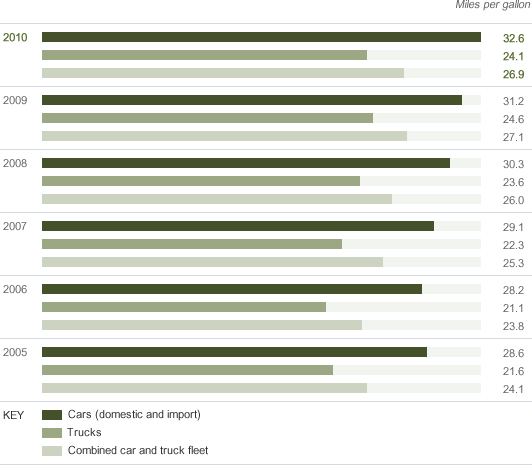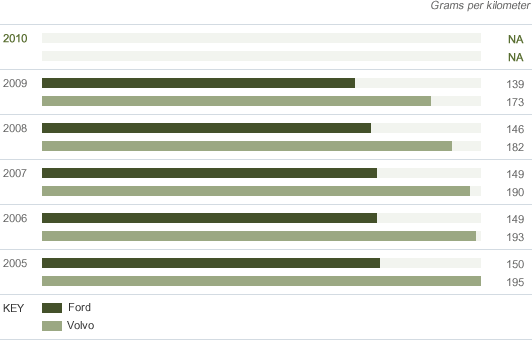Fuel Economy and CO2 Emissions
Data on this page
A. Ford U.S. Corporate Average Fuel Economy

Miles per gallon
| 2005 | 2006 | 2007 | 2008 | 2009 | 2010 | |
|---|---|---|---|---|---|---|
| Cars (domestic and import) | 28.6 | 28.2 | 29.1 | 30.3 | 31.2 | 32.6 |
| Trucks | 21.6 | 21.1 | 22.3 | 23.6 | 24.6 | 24.1 |
| Combined car and truck fleet | 24.1 | 23.8 | 25.3 | 26.0 | 27.1 | 26.9 |
- Reported to regulatory authorities
Notes to Data
The decrease in the combined car and truck year-over-year fuel economy is due to a shift in our mix of vehicles sold, including a longer model year for certain trucks and the removal of Volvo from the 2010 data.
Analysis
For the 2010 model year, our fleet fuel economy declined slightly by about 1 percent relative to the 2009 model year due to a shift in our mix of vehicles sold, including a longer model year for certain trucks and the removal of Volvo from the 2010 data. Preliminary data for the 2011 model year project that the Corporate Average Fuel Economy (CAFE) values for the car and truck fleets will be about the same as the car and truck fleet averages for the 2010 model year. On an overall fleet basis, preliminary estimates indicate a 2011 CAFE improvement of 2.9 percent compared to 2010. The reason the overall fleet average can improve while the individually calculated car and truck fleet averages remain about the same is that there have been changes to the vehicles required to be included in the car and truck categories.
Related Links
- In This Report:
B. Ford U.S. CO2 Tailpipe Emissions Per Vehicle (Combined Car and Truck Fleet Average CO2 Emissions)
Notes to Data
Improvement is reflected in decreasing grams per mile.
Analysis
For the 2010 model year, our fleet CO2 emissions increased slightly by about 1 percent relative to the 2009 model year, but have improved 11 percent compared to the 2006 model year.
Related Links
- In This Report:
C. Ford Europe CO2 Tailpipe Emissions Per Vehicle

Grams per kilometer
| 2005 | 2006 | 2007 | 2008 | 2009 | 2010 | |
|---|---|---|---|---|---|---|
| Ford | 150 | 149 | 149 | 146 | 139 | NA |
| Volvo | 195 | 193 | 190 | 182 | 173 | NA |
Notes to Data
Improvement is reflected in decreasing grams per kilometer.
Based on production data for European markets. European and U.S. fleet CO2 emissions are not directly comparable because they are calculated in different units and because they are assessed based on different drive cycles. In 2009, we switched from reporting European vehicle CO2 emissions as a percent of a 1995 base to reporting actual fleet average CO2 emissions, to parallel our reporting for other regions.
Analysis
In Europe, we have reduced the average CO2 emissions of 2010 model year vehicles by 8.1 percent compared to the 2006 model year (not including Volvo). We have achieved this through the introduction of a variety of innovations, such as advanced common rail diesel engines available across the European model range – including the ECOnetic range of low-CO2 vehicles – and the use of lightweight materials.
Related Links
- In This Report:
- Overview
- Economy Data
- Environment Data
- Society Data

